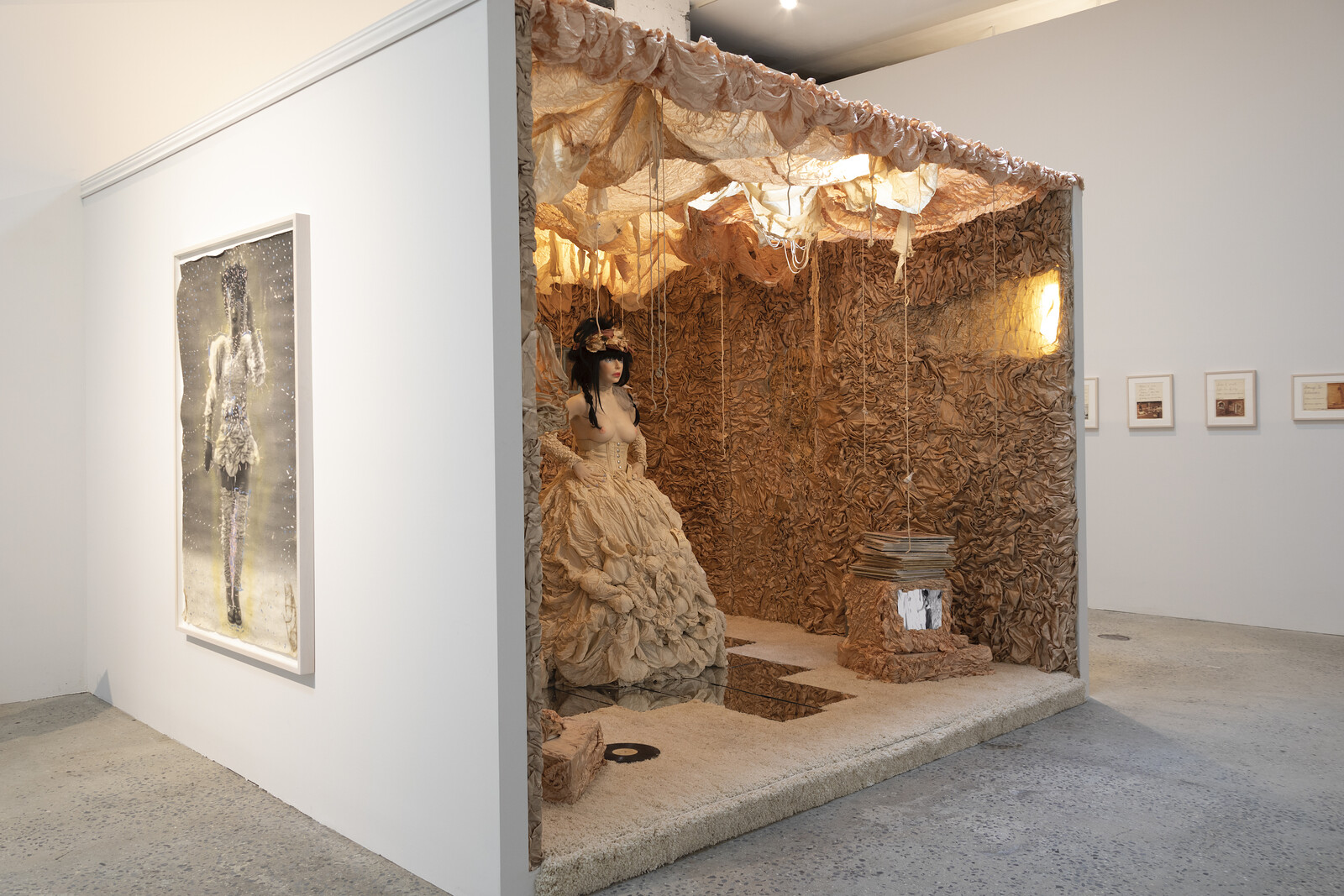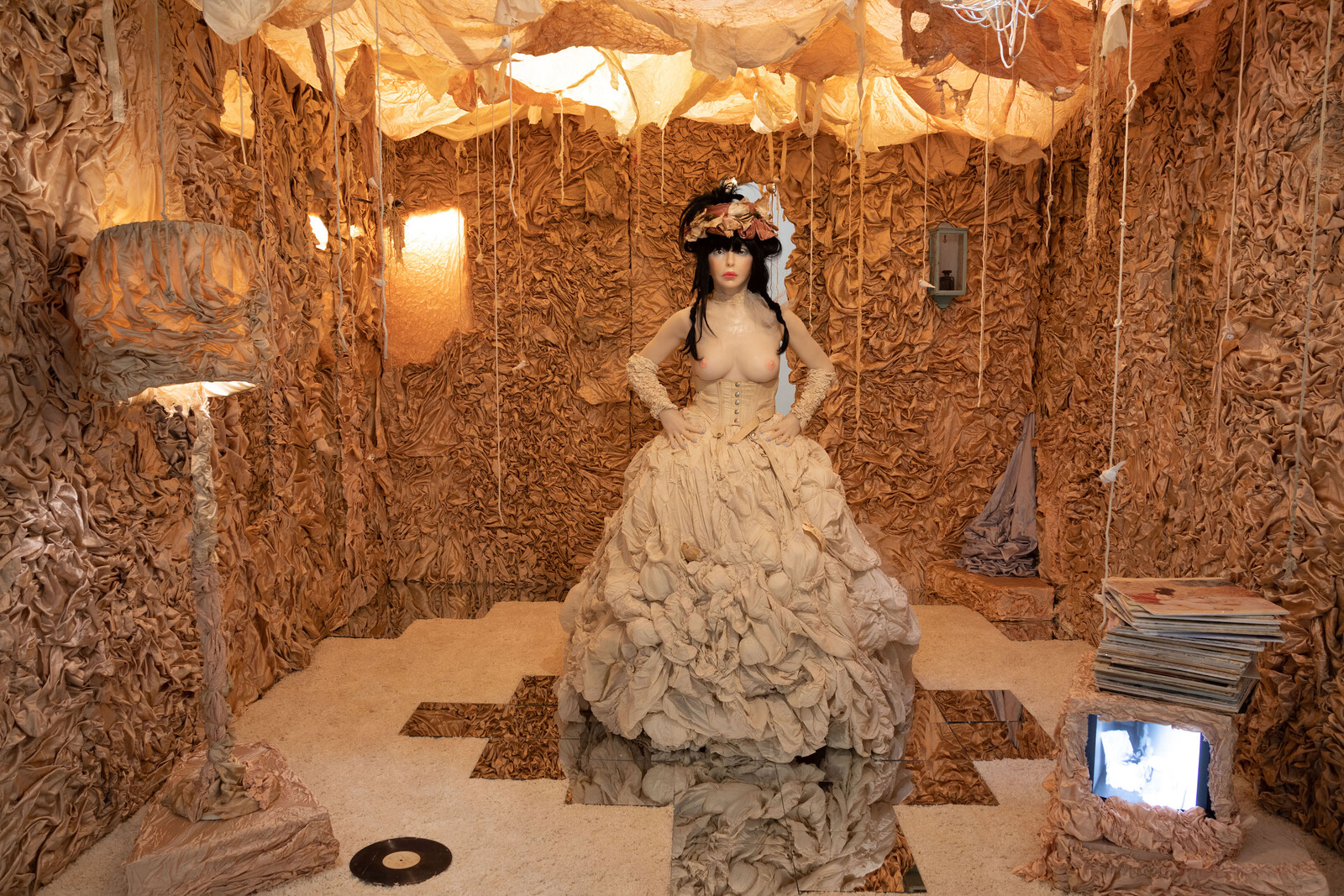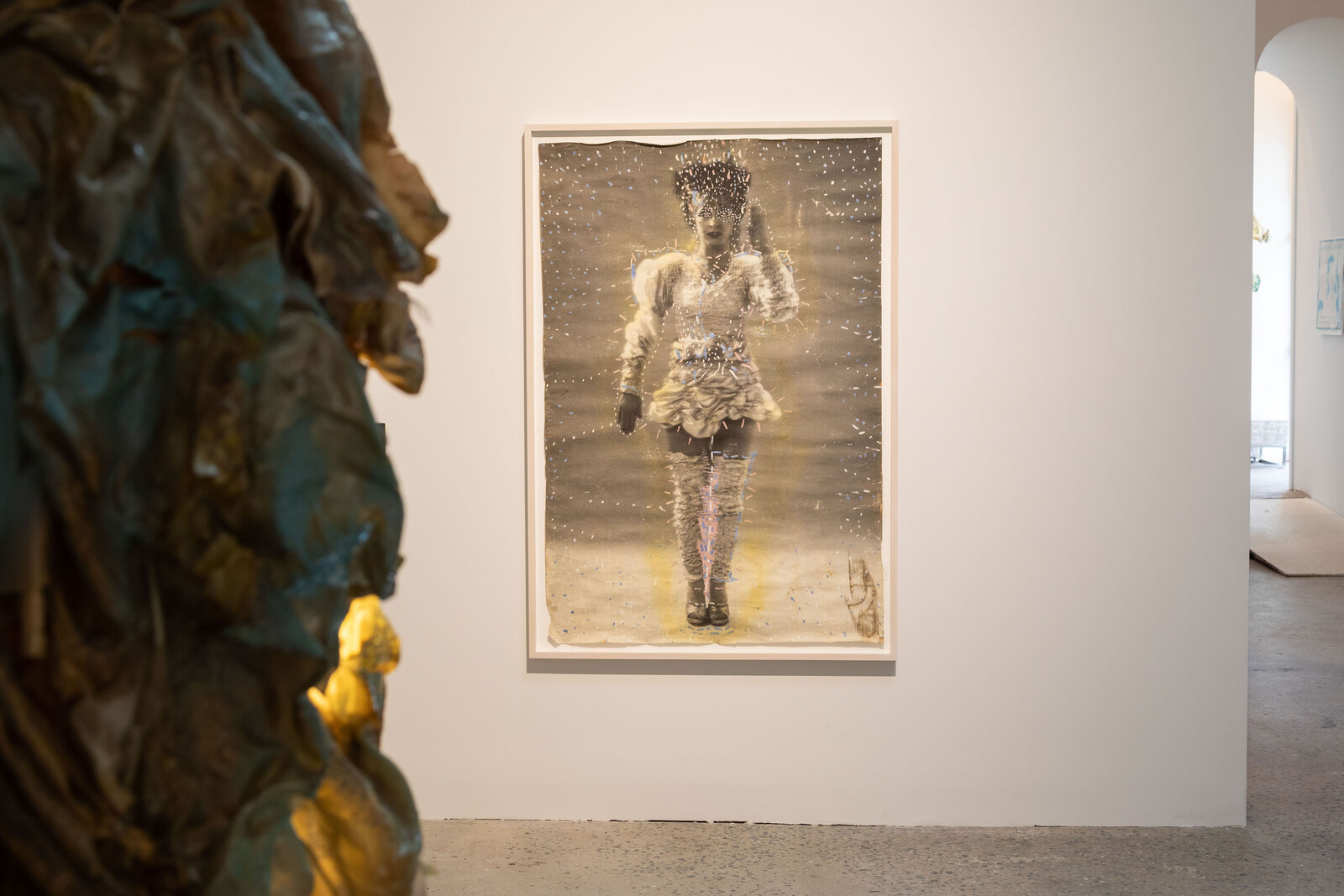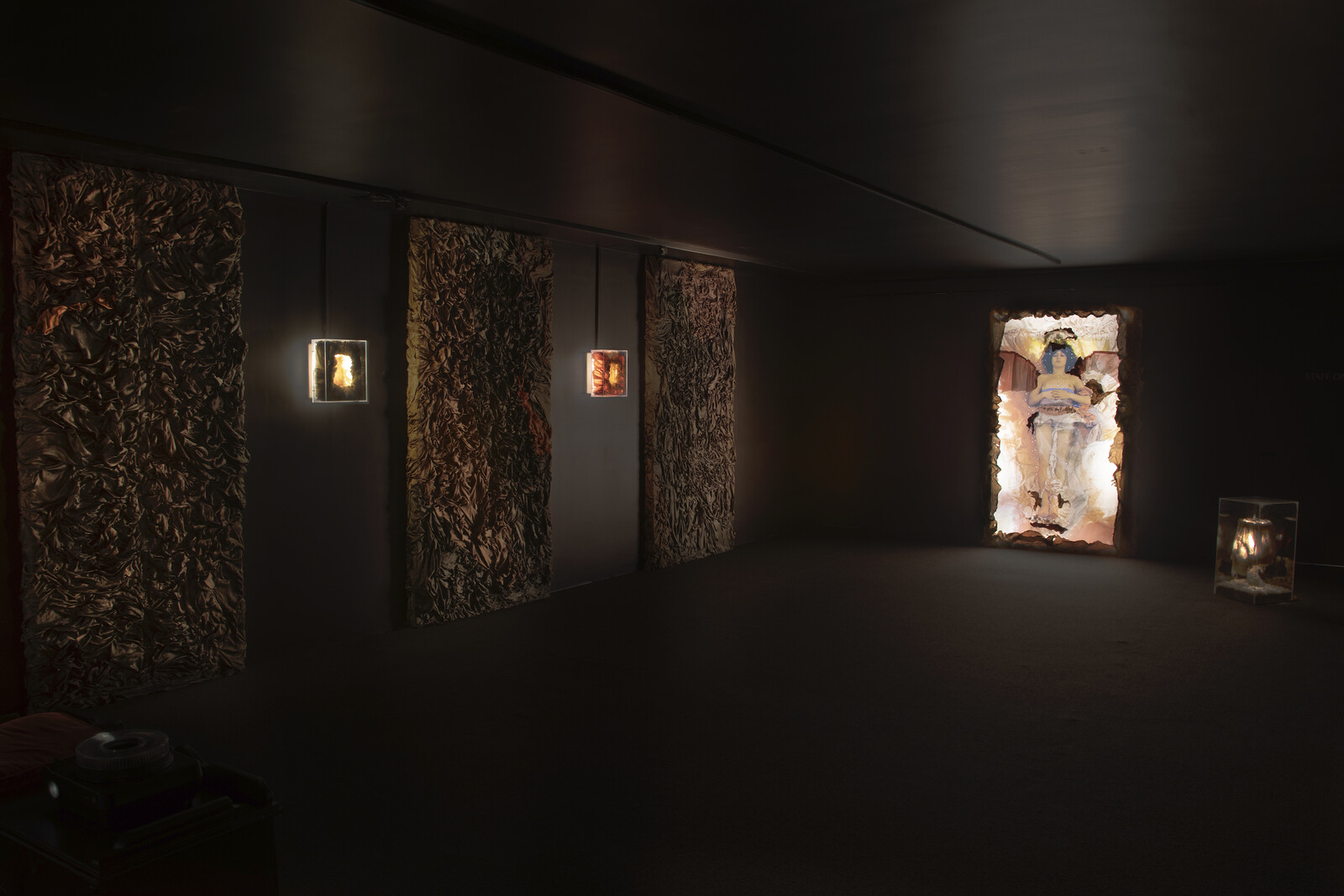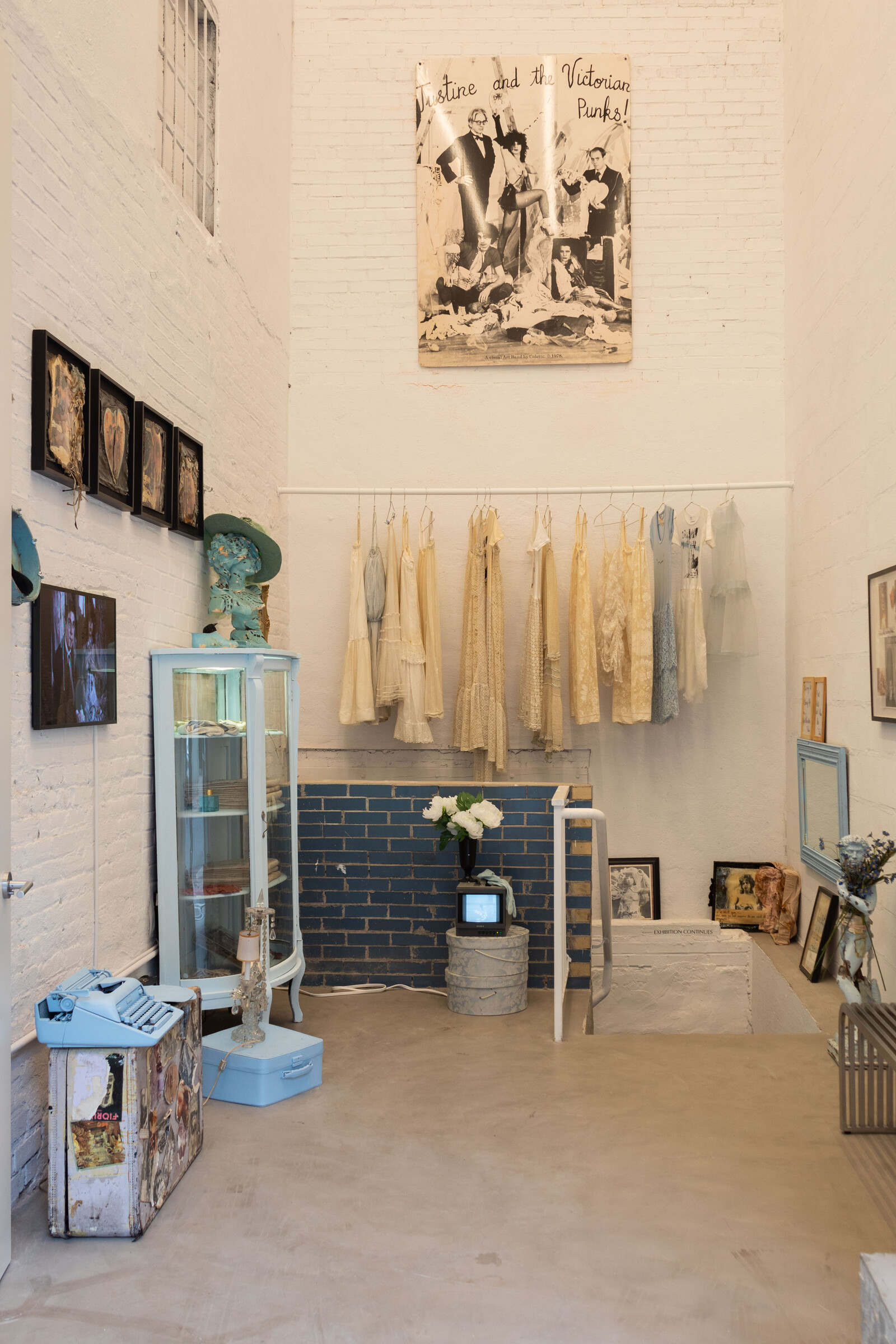Colette Lumiere’s art is unmistakably original, though its reverberations throughout pop culture may inspire feelings of déjà vu. Spanning painting, sculpture, and performance tableaux, as well as interior design, music, fashion, and the branding of various personae, Colette’s “Deadly Feminine” aesthetic crystallized in the New York of the late 1970s and early ’80s. Her work is born of the unique cultural collisions of that time—disco, punk, and new wave; the countercultural underground and the emerging art market; feminist ideology and postmodernism; and a thirst for glamor in a city plagued by crime and bankruptcy. Much like punk’s jarring aesthetics, Colette’s winking appropriation of theatrical femininity (with nods to the bohemian demimonde) has moved from the artistic fringe to a canny marketing posture in pop and art. Her restless and shapeshifting influence has become part of the cultural ether.
This exhibition focuses on the fruitful period of 1972 to ’83. At the show’s core are garments and artifacts from her Living Environment, staged in her Wall Street–adjacent loft during these years. There, Colette suspended satiny ruched fabric in unabashedly feminine shades of blush and cream from every available surface. The look was described by one writer as “suffocating voluptuousness”—a phrase that recalls the fleshiness of the feminized body and the trappings to contain it, from frilly dresses and bedclothes to gussied-up caskets. Colette’s interior design vision extended to matching garments like bodycon dresses and tiered leggings. She sewed both a personal capsule wardrobe and limited-edition fashion collections.
Historically, Colette’s work straddles the postminimalist heyday of performance art and the art/pop crossover of the 1980s onward. Born in Tunisia and raised in France, Colette moved to New York in the late 1960s. She first attracted attention for anonymous paintings executed on desolate downtown streets in the wee hours. In the early 1970s she made a turn to performance and living art, concocting eroticized living tableaux melding the aesthetics of Romantic art and the punk movement. Her debut performance took place in a store window in 1972, where she posed as a version of Eugène Delacroix’s Liberty Leading the People (1830). From there she often created performances embodying tragic “sleeping” heroines, such as Ophelia (at the Akademie der Künste in Berlin, 1976), Camille (at the Museum of Modern Art in 1976), and as Marat in a gender-bending performance titled David’s Wraith (after Jacques-Louis David’s The Death of Marat, 1793) (at PS1 in 1976). Rooted in the 1970s tradition of living-art performances by the likes of Chris Burden, Colette’s reclamation of sleep-as-gesture has recently been echoed by artists like Marina Abramović, Tilda Swinton (2013’s The Maybe at New York’s MoMA), and even the social justice–oriented The Nap Ministry collective founded in 2016.
Although she works across mediums, Colette’s oeuvre primarily revolves around the creation and packaging of her own personae. For most of the 1970s she worked under the mononym Colette—her real first name, given in homage to the French writer Colette (who herself worked under noms de plume). In early 1978, she staged Colette’s death in a performance at the downtown Whitney Museum branch. She resurrected herself, in a second performance at PS1, as Justine: the executor of the Colette Is Dead Co. and the frontwoman of the band Justine & The Victorian Punks. (She took on the moniker Colette Lumiere in 2001, after cycling through alter-egos such as Mata Hari and the Stolen Potatoes, and Countess Reichenbach.) With her punkish shock of dark hair, angular face, heavy makeup, and strategically distressed, ultrafemme clothing, Colette/Justine anticipates Vivienne Westwood’s New Romantic silhouettes of the early 1980s and Madonna’s breakthrough “Like a Virgin” look. (Colette and the Material Girl, both regulars at venues like the Mudd Club and Danceteria, must have crossed paths.) This show contains a fraction of the work Colette made to enshrine these personae, from sculptures and collage to records and limited-edition dresses.
Curator Kenta Murakami takes obvious delight in displaying various artifacts from this riotously productive period in Colette’s creative life. The centerpiece of the exhibition, Notes on Baroque Living (Installation), 1978–83/2021, reconstructs Colette’s fabric-draped Pearl Street loft and includes a life-sized doll replica of the artist, created by sculptor Cajsa von Zeipel. This installation is flanked by Colette’s vintage output of the 1970s, including original photographs documenting various performances with handwritten captions. More successful are her sculptural lightbox objects, in which Colette embeds photographic images of herself in various guises and envelops them in swathes of fabric.
As Colette moved into her Justine period, her output became focused on the relationship between art and economic exchange. By staging Colette’s death, she reasoned, the prices for Colette’s work would rise. She called her works of the early 1980s “Reverse Pop,” bringing art objects into the commercial realm and vice versa, all while riling up bourgeois sensibilities. A related mixed-media work in a gilded frame, featuring an image of a sensuously reclining Colette overlaid with tufts of diaphanous fabric, contains the stenciled phrase: “If men want to look at me, why shouldn’t they pay for it?” Against the backdrop of Justine’s punky dresses, sold as the “Deadly Feminine” (a translation of “femme fatale”) line at the iconic boutique Fiorucci, boast screenprinted catchphrases from her songs, such as “I’m A Work of Art” and “Handle With Care.”
Underlining Colette’s contribution to the music world, the dreamlike video Colette in Her Living Environment (1979) is scored with the 1979 Justine & the Victorian Punks LP “Beautiful Dreamer.” Called a disco version of the well-known parlor song, Justine’s rendition features driving funk bass, a sax played by composer Peter Gordon, and the artist’s baby-voiced recitation of the lyrics. Reissued by the DFA label in 2010, the song stands the test of time. A related video, Justine and the Boys (1979), reveals a more troubling dynamic (and some bad acting) in the Living Environment. A long establishing scene of the 50-minute videotape features Colette preening bare-breasted in a bubble bath, engaging in stilted dialogue with her then-boyfriend Jeff Koons. Just a year away from beginning his work as a commodity trader, Koons perches at the edge of the tub in a pristine business suit. Later, Colette plays host in her loft to artworld friends like Richard Prince and critic Alan Jones. The video concludes with a short haggle between buyers over Colette’s $37,000 bed—and presumably, the artist herself—while she dozes in her “Beautiful Dreamer” getup. “It’s a gimmick,” the only female visitor in Colette’s studio/home complains.
The video’s tone is tongue-in-cheek, yet the work reveals painful fault lines in the art world. Colette has continuously evolved her personae over the years to avoid being copied and performed her own death to raise her work’s value. Her rent-stabilized loft is gone—sold to developers and bulldozed in 2007—even as her work grows in symbolic value for its frank approach to sexuality, economics, and branding. Meanwhile, the male artists in her social circle have achieved blue-chip recognition and astronomical prices for engaging in similar tactics of appropriation. Colette’s work testifies not only to the creative value of the time in which she emerged, but to her transformative resilience in a market that has often tokenized difference as a background effect—sexual, racial, and otherwise—while keeping the spotlight on white male artists. This exhibition champions Colette’s magnetic main character energy.
